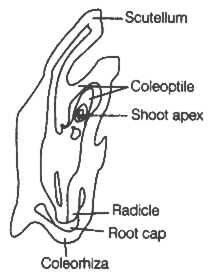 Short Answer Type
Short Answer TypeState what is apomixis. Comment on its significance. How can it be commercially used?
 Long Answer Type
Long Answer Type(a) Explain the different ways apomictic seeds can develop. Give an example of each.
(b) Mention one advantage of apomictic seeds to farmers.
(c) Draw a labelled mature stage of a dicotyledonous embryo. Short Answer Type
Short Answer TypeOut of many papaya plants growing in your garden, only a few bear fruits. Give reason.
 Long Answer Type
Long Answer Type(a) Explain the post-pollination events leading to seed production in angiosperms.
(b) List the different types of pollination depending upon the source of pollen grains.
 Short Answer Type
Short Answer TypeA. Draw a labelled diagram of L.S. of an embryo of grass (any six labels).
B, Give reason for each of the following:
(i) Anthers of angiosperm flowers are described as dithecous.
(ii) Hybrid seeds have to be produced year after year.
(A) L.S. of an embryo of grass.
. 
B
i. Each anther of the angiosperm flower is bilobed in nature with two layered protection called theca (dithecous). Each theca is separated by longitudinal grooves. Bilobed nature is distinct in transverse section, microsporangia is located at the corners of the tetragonal structure.
